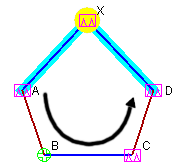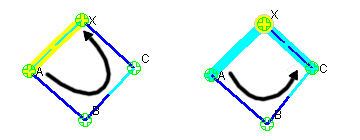- play_arrow Introduction
- play_arrow Router Data Extraction
- play_arrow Routing Protocols
- play_arrow Equal Cost Multiple Paths
- play_arrow Static Routes
- play_arrow Policy-Based Routes
- play_arrow Border Gateway Protocol
- NorthStar Planner Border Gateway Protocol Overview
- Border Gateway Protocol Recommended Instructions
- BGP Data Extraction
- BGP Reports
- BGP Options
- BGP Map
- BGP Live Status Check
- BGP Routing Table
- BGP Routes Analysis
- BGP Information at a Node
- BGP Neighbor
- Apply, Modify, or Add BGP Polices
- BGP Subnets
- Getipconf Usage Notes
- BGP Report
- play_arrow Virtual Private Networks
- NorthStar Planner Virtual Private Networks Overview
- Import VPN Information from Router Configuration Files
- Viewing the Integrity Checks Reports
- Accessing VPN Summary Information
- Accessing Detailed Information for a Particular VPN
- VPN Topology View
- Route-Target Export/Import Relationships
- Additional Methods to Access VPN Information
- VPN Path Tracing
- VPN Design and Modeling Using the VPN Wizard
- L3 (Layer 3) VPN
- L3 Hub-and-Spoke VPN
- L2M (Layer2-Martini) VPN
- L2K (Layer2-Kompella) VPN
- VPLS-BGP VPN (for Juniper)
- VPLS-LDP VPN
- L2CCC (Circuit Cross-Connect) VPN
- Inter-AS VPN
- Forming VPN Customer Groups
- Deleting or Renaming VPNs
- VPN Configlet Generation
- Adding Traffic Demands in a VPN
- VPN Traffic Generation
- VPN-Related Reports
- VPN Monitoring and Diagnostics
- play_arrow GRE Tunnels
- play_arrow Multicast
- NorthStar Planner Multicast Overview
- NorthStar Planner Recommended Multicast Instructions
- Creating Multicast Groups
- Create Multicast Demands
- Viewing Multicast Demands in the Network
- Comparing Multicast with Unicast
- Multicast SPT Threshold
- Multicast Reports
- Multicast Simulation
- Collecting Multicast Path Data from Live Network
- Importing Multicast Path Data
- Multicast Data Processing
- Viewing Multicast Trees
- play_arrow Class of Service
- NorthStar Planner Class of Service Overview
- NorthStar Planner Recommended CoS Instructions
- The QoS Manager
- Define Class Maps
- Create Policies for Classes
- Attach Policies to Interfaces
- Adding Traffic Inputs
- Using the Text Editor
- Reporting Module
- IP Flow Information
- Link information
- Traffic Load Analysis
- Traffic Load by Policy Class
- CoS Alias File
- Bblink File
- Policymap File
- Demand File
- Traffic Load File
- play_arrow Routing Instances
- play_arrow Traffic Matrix Solver
- play_arrow LSP Tunnels
- NorthStar Planner LSP Tunnels Overview
- Viewing Tunnel Info
- View Primary and Backup Paths
- Viewing Tunnel Utilization Information from the Topology Map
- Viewing Tunnels Through a Link
- Viewing Demands Through a Tunnel
- Viewing Link Attributes/Admin-Group
- Viewing Tunnel-Related Reports
- Adding Primary Tunnels
- Adding Multiple Tunnels
- Mark MPLS-Enabled on Links Along Path
- Modifying Tunnels
- Path Configuration
- Specifying a Dynamic Path
- Specifying Alternate Routes, Secondary and Backup Tunnels
- Add and Assign Tunnel ID Groups
- Making Specifications for Fast Reroute
- Specifying Tunnel Constraints (Affinity/Mask or Include/Exclude)
- Adding One-Hop Tunnels
- Tunnel Layer and Layer 3 Routing Interaction
- play_arrow Optimizing Tunnel Paths
- play_arrow Tunnel Sizing and Demand Sizing
- play_arrow Tunnel Path Design
- Tunnel Path Design Overview
- Tunnel Path Design Instructions
- Designing Tunnel Paths Overview
- Backup Path Configuration Options
- Default Diversity Level
- Evaluate/Tune Options
- Advanced Options
- Viewing Design Results
- Tunnel Modifications
- Exporting and Importing Diverse Group Definitions
- Advanced Path Modification
- play_arrow Inter-Area MPLS-TE
- play_arrow Point-to-Multipoint (P2MP) Traffic Engineering
- NorthStar Planner P2MP Traffic Engineering Overview
- Point-to-Multipoint Traffic Engineering Instructions
- Import a Network That Already has Configured P2MP LSP Tunnels
- Examine the P2MP LSP Tunnels
- Create P2MP LSP Tunnels and Generate Corresponding LSP Configlets
- Examine P2MP LSP Tunnel Link Utilization
- Perform Failure Simulation and Assess the Impact
- play_arrow Diverse Multicast Tree Design
- Diverse Multicast Tree Design Overview
- Diverse Multicast Tree Instructions
- Open a Network That Already Has a Multicast Tree
- Set the Two P2MP Trees of Interest to be in the Same Diversity Group
- Using the Multicast Tree Design Feature to Design Diverse Multicast Trees
- Using the Multicast Tree Design Feature
- play_arrow DiffServ Traffic Engineering Tunnels
- DiffServ Traffic Engineering Tunnels Overview
- Using DS-TE LSP
- Hardware Support for DS-TE LSP
- NorthStar Planner Support for DS-TE LSP
- Configuring the Bandwidth Model and Default Bandwidth Partitions
- Forwarding Class to Class Type Mapping
- Link Bandwidth Reservation
- Creating a New Multi-Class or Single-Class LSP
- Configuring a DiffServ-Aware LSP
- Tunnel Routing
- Link Utilization Analysis
- play_arrow Cisco Auto-Tunnels
- play_arrow Integrity Check Report
- play_arrow Compliance Assessment Tool
- Compliance Assessment Tool Overview
- Using The Compliance Assessment Tool
- CAT Testcase Design
- Creating a New Project
- Loading the Configuration Files
- Creating Conformance Templates
- Reviewing and Saving the Template
- Saving and Loading Projects
- Run Compliance Assessment Check
- Compliance Assessment Results
- Publishing Templates
- Running External Compliance Assessment Scripts
- Scheduling Configuration Checking in Task Manager
- Building Templates
- Special Built-In Functions
- Paragon Planner Keywords For Use Within a Rule
- More on Regular Expressions
- IP Manipulation
- play_arrow Virtual Local Area Networks
- play_arrow Overhead Calculation
- play_arrow Router Reference
Link, Site and Facility Diverse Paths
From the FRR Design window, the Diversity Level parameter allows you to specify whether the routes for the FRR-designed backup paths should be Facility-diverse, Site-diverse or Link-diverse from the primary paths. NorthStar Planner will then try its best to satisfy the requirements. If a diverse backup path cannot be found, the software will still attempt to route the backup tunnel if possible. In this situation, if it is routed, this LSP tunnel will fall into the No-Diversity category. If it cannot be routed, it will fall under the Unplaced category.
Link Diversity
Link diversity is the most fundamental diversity level. Figure 371 depicts a link-diverse route in the event of a link failure or a node failure. In the diagram on the left, the protected link is the link between A and B. A FRR-LP link-diverse route from A to B is any path that avoids the link between A and B.
The diagram at right depicts a protected node B on the path between nodes A and C. A FRR-NP link-diverse route is technically any path that avoids both the link between A and B as well as node B.

Site Diversity
A site is a user-defined group of nodes, specified in a site file. If no site file is specified, then by default sites are mapped with individual routers listed in the node (muxloc) file. Sites are typically defined to indicate a group of nodes that are likely to fail together. Figure 372 depicts a protected node X between A and D. For this example, to establish a site-diverse route, nodes B and C must not belong to the same site as node X.

If no site-diverse route exists, the program will attempt to find a link-diverse route, under the presumption that an alternate route is better than none.
When completing an FRR Design with the Diversity Level set to Link or Site, the Console will report a summary for all the FRR Backup tunnels, in a format similar to that below:
Diversity Level= Link or SITE Tunnel Site-Diversity Link-Diversity No-Diversity Unplaced FRRBackup 34 0 54 0
The Tune FRR Backup Tunnels window, if open, will also display Site, Link, or None, accordingly, in the Diversity column.
Site-Diversity in this context simply means Site Diversity. It does not indicate Site + Facility Diversity as is the case when the Diversity Level is set to Facility.
Facility Diversity (SRLG)
A Shared Risk Link Group (SRLG) can be represented by the concept of a facility in NorthStar Planner,, indicating a group of links that are likely to go down together in the event of a failure.
In NorthStar Planner, a facility can be defined in a special facility file as a group of links and nodes. A backup path that is facility-diverse from its primary path will have a route that, aside from the source and destination, will traverse a path that does not intersect with the primary path at any of a facility’s links or nodes.
In Figure 2, the diagram at left depicts a protected link between A and X, highlighted in yellow.
The alternate route depicted from A to X is only facility-diverse if links A->B, B->C, C->X, along with nodes B and C do not belong to the same facility as link A->X. The diagram at right depicts a protected node X. The alternate FRR-NP route depicted from A to C is only facility-diverse if links A->B, B->C and node B do not belong to the same facility as either link A->X or node X.
If no facility-diverse route exists, the program will attempt to find a site-diverse route, under the presumption that an alternate route is better than none.
If the network model was built from the configuration files through the Import Data Wizard feature described in Router Data Extraction Overview, then by default a facility will be set equivalent to all links associated with a router card.

When completing an FRR Design with the Diversity Level set to Facility, the Console will report a summary for all the FRR Backup tunnels, in a similar format to that below:
Diversity Level= FACILITY Tunnel Site-Diversity FAC-Diversity No-Diversity Unplaced FRRBackup 37 0 51 0
The Tune FRR Backup Tunnels window, if open, will also display Site, Facility, or None, accordingly, in the Diversity column.
Site-Diversity in this context may be somewhat misleading. If the Diversity Level was set to Facility, then Site-Diversity, both in the Console and in the Tune FRR Backup Tunnels window, actually indicates that Site Diversity + Facility Diversity are both satisfied. This is stronger than simply Facility (FAC)-Diversity alone.





















